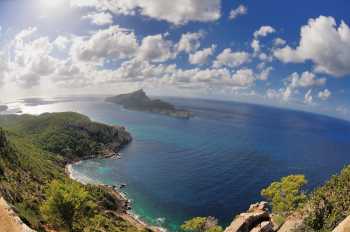
The uninhabited island of Sa Dragonera (356 ha, maximum height 349 m) with its striking limestone cliffs lies off the north-western coast of Mallorca, one of the Spanish Balearic Islands in the western Mediterranean.
In 2011 Black Rats Rattus rattus and House Mice Mus musculus were eradicated from the island, which is a natural park and forms part of the Nature 2000 network.
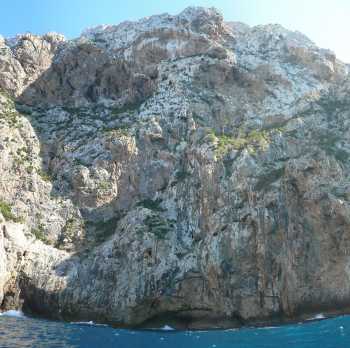
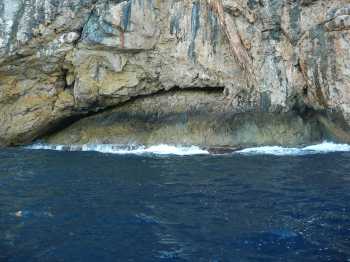 The narrow slit of sa Cella (“eyebrow” in Catalan) cave on Mallorca near sa Dragonera (and part of the same natural park) gives access to an estimated 200 breeding pairs of Critically Endangered and ACAP-listed Balearic Shearwaters Puffinus mauretanicus - as well as to researchers since 1982. Up until the 1970s local fishers visited the cave to collect shearwaters to use as bait for bottom longlines. Sa Cella is the largest existing Balearic Shearwater cave colony in the Balearic Islands – which support 30 known breeding sites. Balearic Shearwaters also breed on sa Dragonera.
The narrow slit of sa Cella (“eyebrow” in Catalan) cave on Mallorca near sa Dragonera (and part of the same natural park) gives access to an estimated 200 breeding pairs of Critically Endangered and ACAP-listed Balearic Shearwaters Puffinus mauretanicus - as well as to researchers since 1982. Up until the 1970s local fishers visited the cave to collect shearwaters to use as bait for bottom longlines. Sa Cella is the largest existing Balearic Shearwater cave colony in the Balearic Islands – which support 30 known breeding sites. Balearic Shearwaters also breed on sa Dragonera.
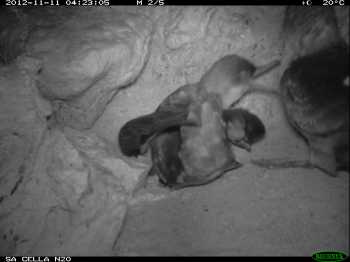
Infrared, red lights and night-vision scopes are used to observe the natural behaviour of the Balearic Shearwaters in the pitch-dark cave - seen here fighting. White light and flash are used on very few occasions. The nests are hidden in the depths of the cave, some a few hundred metres from the entrance in complete darkness. The birds seem to find their way without problem.
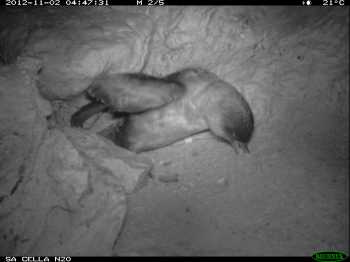
A male shearwater digs with its bill, preparing the nesting chamber for the 2013 breeding season. The bird carries a plastic band with a geolocator attached (click here for more information on the at-sea tracking study conducted from the cave). Activity in the cave is quite chaotic during the pre-breeding period with a lot of calling and fighting. Once the breeding season has advanced the birds are busier looking for food at sea and the cave becomes quiet.
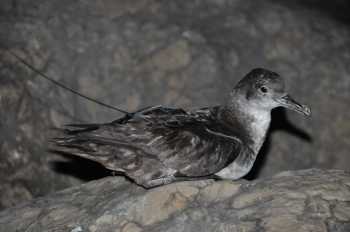
A Balearic Shearwater shows its satellite tag aerial
Photograph courtesy of Henri Weimerskirch
Selected References:
Arcos, J.M. (compiler) 2011. International Action Plan for the Balearic Shearwater, Puffinus mauretanicus. Madrid: SEO/BirdLife & Cambridge: BirdLife International. 49 pp.
Gallo-Orsi, U. 2003. Species Action Plans for the conservation of seabirds in the Mediterranean Sea: Audouin’s Gull, Balearic Shearwater and Mediterranean Shag. Scientia Marina 67 (Suppl. 2): 47-55.
Guilford, T. Wynn, R., McMinn, M., Rodríguez, A., Fayet, A., Maurice, L., Jones, A. & Meier, R. 2012. Geolocators reveal migration and pre-breeding behaviour of the Critically Endangered Balearic Shearwater Puffinus mauretanicus. PLoS ONE 7(3): e33753. doi:10.1371/journal.pone.0033753.
Louzao, M., Delord, K., García, D., Boué, A. & Weimerskirch, H. 2012. Protecting persistent dynamic oceanographic features: transboundary conservation efforts are needed for the Critically Endangered Balearic Shearwater. PLoS ONE 7(5): e35728. doi:10.1371/journal.pone.0035728.
Mayol, J., Mayol, M., Domenech, O., Oliver, J., McMinn, M. & Rodríguez, A. 2012. Aerial broadcast of rodenticide on the island of Sa Dragonera (Balearic Islands, Spain). A promising rodent eradication experience on a Mediterranean island. Aliens 32: 29-32.
Oro, D., Aguilar, J.S., Igual, J.M. & Louzao, M. 2004. Modelling demography and extinction risk in the endangered Balearic Shearwater. Biological Conservation 116: 93-102.
Click here to access the ACAP Species Assessment for the Balearic Shearwater.
All photographs by Miguel McMinn unless stated.
Miguel McMinn, Skua Gabinet d'Estudis Ambientals SLP, Mallorca and John Cooper, ACAP Information Officer, 24 February 2013, updated 25 February 2013

 English
English  Français
Français  Español
Español